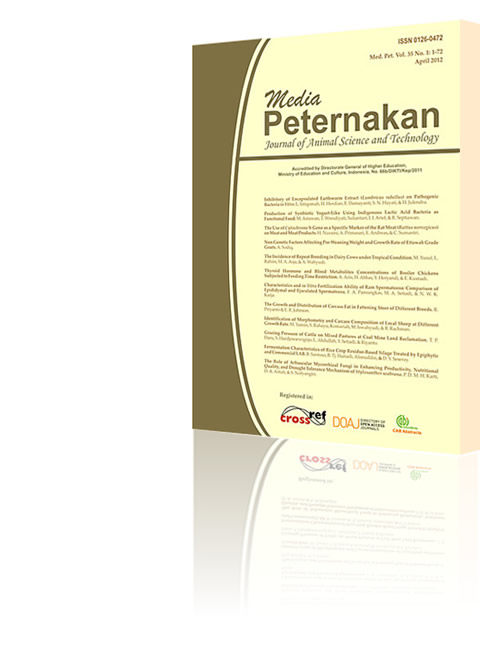-
L Istiqomah
-
H Herdian
-
E Damayanti
-
S N Hayati
-
H Julendra
Keywords:
antibacterial, encapsulation, earthworm L. rubellus, extract
Abstract
The objective of this study was to determine the inhibitory of earthworm (Lumbricus rubellus) extract (ECT) and encapsulated earthworm extract (ECT-t) as poultry feed additive against some pathogenic bacteria. Earthwom extract was prepared by dekokta method with water at 90 ºC then encapsulated by spray drying with maltodextrin as filler. In vitro antibacterial activity was performed using dilution method against Escherichia coli, Staphylococcus aureus, Salmonella pullorum, and Pseudomonas aeruginosa. The optical density results showed that started from ECT level 0.26% inhibited (PP. aeruginosa and S. aureus, while ECT level 0.52% inhibited (PE. coli and S. pullorum along with the increased levels of concentration. The percentage of growth showed that ECT level 1.04% had inhibitory (PE. coli and P. aeruginosa, while ECT level 0.52% showed antibacterial activity (PS. aureus. The result showed that S. aureus was the most sensitive bacterium to earthworms extract. ECT-t level 0.78% and 1.04% measured by spectrophotometer showed inhibitory (PP. aeruginosa and S. pullorum respectively. While ECT-t level 0.26% measured by spread plate count method showed inhibitory activity against P. aeruginosa. LD50 of E. coli and P. aeruginosa were found at ECT level 1.04%, while LD50 of S. aureus was found at level 0.52%. LD50 of P. aeruginosa was found at ECT-t level 0.52%. There were no antibacterial action (P>0.05) of ECT and ECT-t against S. pullorum.
Downloads
Download data is not yet available.
Author Biographies
L Istiqomah
Research Unit for Processes Development & Chemical Engineering (UPT. BPPTK),
Indonesian Institute of Sciences (LIPI)
Jln. Jogja-Wonosari Km. 31, Gading, Playen, Gunungkidul, Yogyakarta 55861, Indonesia
H Herdian
Research Unit for Processes Development & Chemical Engineering (UPT. BPPTK),
Indonesian Institute of Sciences (LIPI)
Jln. Jogja-Wonosari Km. 31, Gading, Playen, Gunungkidul, Yogyakarta 55861, Indonesia
E Damayanti
Research Unit for Processes Development & Chemical Engineering (UPT. BPPTK),
Indonesian Institute of Sciences (LIPI)
Jln. Jogja-Wonosari Km. 31, Gading, Playen, Gunungkidul, Yogyakarta 55861, Indonesia
S N Hayati
Research Unit for Processes Development & Chemical Engineering (UPT. BPPTK),
Indonesian Institute of Sciences (LIPI)
Jln. Jogja-Wonosari Km. 31, Gading, Playen, Gunungkidul, Yogyakarta 55861, Indonesia
H Julendra
Research Unit for Processes Development & Chemical Engineering (UPT. BPPTK),
Indonesian Institute of Sciences (LIPI)
Jln. Jogja-Wonosari Km. 31, Gading, Playen, Gunungkidul, Yogyakarta 55861, Indonesia
Authors submitting manuscripts should understand and agree that copyright of manuscripts published are held by Media Peternakan. The statement to release the copyright to Media Peternakan is stated in Form A. This work is licensed under a Creative Commons Attribution-ShareAlike 4.0 International License (CC BY-SA) where Authors and Readers can copy and redistribute the material in any medium or format, as well as remix, transform, and build upon the material for any purpose, but they must give appropriate credit (cite to the article or content), provide a link to the license, and indicate if changes were made. If you remix, transform, or build upon the material, you must distribute your contributions under the same license as the original.



